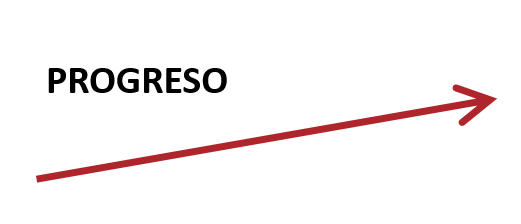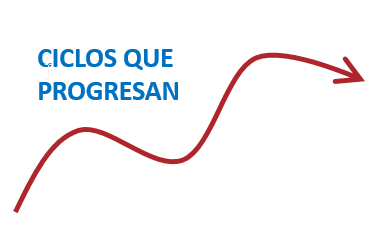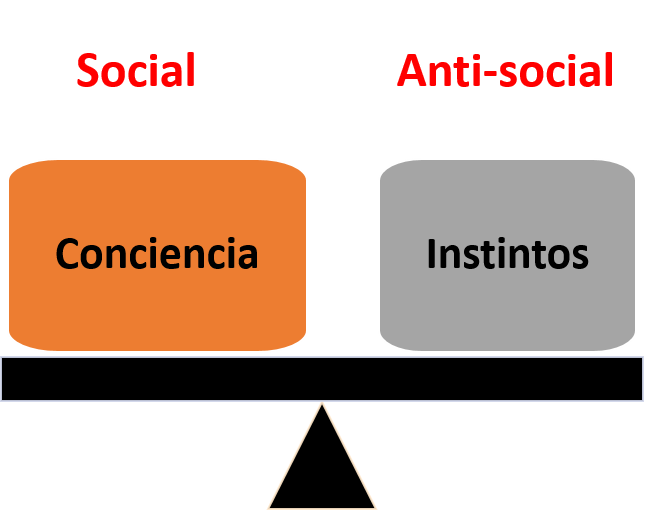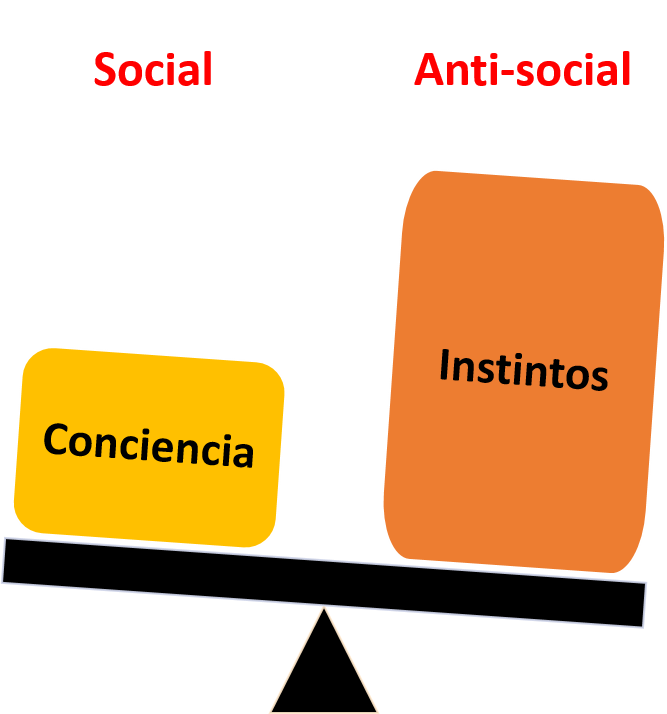Esta es la segunda parte del escrito «Teoría de ciclos».
En la primera parte, explicábamos porqué la historia humana se da con una combinación de progreso y ciclos.
En esta segunda parte, explicamos un modelo de la conducta humana que explica los ciclos a pequeña escala (unas pocas generaciones).
En la tercera parte, extenderemos este modelo para explicar los ciclos a gran escala de las civilizaciones.
1. Los dos tipos de aprendizaje
En la parte anterior, vimos que el ser humano cuenta con dos tipos de aprendizaje:
- El aprendizaje intelectual son los conocimientos que se adquieren de forma intelectual: leyendo libros, asistiendo a la escuela, haciendo experiementos científicos o simplemente porque alguien nos los explica .
- El aprendizaje vivencial son las actitudes que se adquieren de forma vivencial (en la escuela de la vida, por así decirlo). No las puedes aprender bien si no las vives, pues se aprenden de forma emocional y no intelectual.
El aprendizaje intelectual es fácil de transmitir eficientemente entre generaciones y, por ello, siempre se acumula, por lo que, respecto a este tipo de aprendizaje, la historia siempre progresa (con excepciones marcadas).

El aprendizaje vivencial no se puede transmitir eficientemente entre generaciones y, por tanto, se va perdiendo conforme pasa el tiempo. Cuando se pierde, la nueva generación debe aprenderlo desde cero. Esto quiere decir que, con respecto a este tipo de aprendizaje, la historia funciona en ciclos.

Por lo tanto, la evolución de la historia es la resultante de estas dos fuerzas: un progreso a largo plazo pero ciclos a corto plazo.

En este escrito, nos preocupamos sólo del comportamiento de ciclos del aprendizaje vivencial, es decir, del segundo de los gráficos que se han mostrado hasta ahora. Se supone que el comportamiento del progreso del aprendizaje intelectual se explica por sí solo, a partir de la acumulación de conocimientos.
Los ciclos más grandes tienen una duración entre mil y tres mil años y corresponden al ascenso y caída de las civilizaciones. Pero dentro de cada civilización y dentro de cada cultura, existen ciclos más pequeños y, dentro de estos ciclos más pequeños, ciclos aún más pequeños. El ciclo más pequeño a nivel social es el ciclo económico, en el que una expansión va seguida por una recesión. Este ciclo ya está registrado en la Biblia para el antiguo Egipto de los faraones. La Biblia lo llama «siete años de vacas gordas y siete años de vacas flacas» (Genesis 41, 1-36).
Esto se cumple también a nivel personal. Una familia puede tener ciclos que duran generaciones. Por ejemplo, como hemos dicho, es bien sabido que, en media, una empresa familiar en España dura tres generaciones: la primera generación crea la empresa con gran esfuerzo, la segunda la mantiene y la tercera la despilfarra.
De forma más limitada, una persona también suele pasar por ciclos más pequeños de aprendizaje vivencial: es típico el ciclo del joven que comienza la vida de forma favorable, no hace caso a sus mayores cuando le dicen que deje la mala vida, entra en una situación desesperada (pobreza, adicción a drogas), se recupera y aprende lo que sus mayores le habían dicho desde un principio (pero de forma vivencial, ya que fue imposible que lo aprendiera de forma intelectual, cuando sus mayores se lo explicaban). En la Biblia esta es la historia del Hijo Pródigo.
Sin embargo, queda por explicar por qué algunos conocimientos se pueden aprender intelectualmente y otros conocimientos deben aprenderse vivencialmente. Esto tiene sus raíces en la naturaleza humana y debe explicarse de manera más detallada, lo que hacemos a continuación.
2. Qué tipo de conocimientos deben aprenderse vivencialmente
Resulta extraño que algunos conocimientos se deban de experimentar viviéndolos. Como hemos explicado en otra parte, el ser humano tiene aspectos innatos y aprendidos. Sin embargo, casi todo lo que hemos aprendido proviene de cosas que hemos aprendido de nuestros semejantes, desde los aspectos más cotidianos hasta nuestros conocimientos más avanzados pasando por nuestro sueños más queridos. Esto es lo que el antropólogo René Girard llama «la mímesis». Como especie humana, somos una especie imitativa, lo aprendemos casi todo imitando a otros.
Sin embargo, hay algunos tipos de conocimientos que es imposible que los aprendamos sin vivirlos nosotros mismos (el aprendizaje vivencial). Esto es muy extraño.
Tomemos el caso del joven que sus mayores dicen que debe ahorrar pero despilfarra toda su fortuna en drogas, productos caros, mujeres y fiestas hasta que se da cuenta de que esto lo lleva al desastre, reflexiona y vuelve a las buenas costumbres (esta especie de hijo pródigo moderno). Este joven no ha podido aprender de forma intelectual que la mala vida no va a ningún sitio y ha tenido que aprenderlo de forma vivencial («aprendió a las bravas», como dicen los latinoamericanos).
Sin embargo, este joven no ha tenido ningún problema en aprender de forma intelectual a evitar la mayoría de comportamientos autodestructivos. Cuando su padre le dijo que no metiera sus dedos en un enchufe, él le hizo caso, sin necesitar meter los dedos en un enchufe para comprobarlo. Cuando su padre le enseñó que en la autopista debía ir por el carril que corresponde a su sentido, él hizo caso, sin tener que meterse en el otro sentido para comprobarlo. Cuando llega a la universidad y encuentra un hoyo profundo con un letrero «No pasar», no se lanza en el hoyo para ver si esto es cierto.
En general, el joven hace caso a sus semejantes en casi todo. Puede aprender de forma intelectual incluso las cosas más pragmáticas, sin necesidad de experimentarlas. En caso contrario, la civilización no existiría y seguiríamos en la prehistoria, pues cada persona debería aprenderlo todo desde cero. ¿Qué es lo que hace que unas cosas sean tan difíciles de aprender intelectualmente y sea necesario aprenderlas vivencialmente?
Las cosas que deben aprenderse vivencialmente son cosas que van contra los instintos más básicos del ser humano: el instinto de supervivencia, de alimentación, de poder, de estatus, de placer y de sexo. A estos instintos los llamaremos «instintos primitivos», «instintos egoístas», «egoismo» o, como los llamó la Iglesia Católica, «pasiones» (o también los llama «la carne» y «el mundo»).
Así, por ejemplo, cuando el joven del ejemplo anterior oye a sus mayores que la mala vida no le lleva a ningún sitio, entiende intelectualmente el mensaje. Sin embargo, renunciar a la mala vida significaría renunciar al estatus (productos caros), placer (fiestas y drogas) y sexo (mujeres). Esto va contra sus instintos primitivos (egoísmo). Por eso, el joven desoye a sus mayores y se dedica a la mala vida. Sólo cuando está en el desastre y ya no obtiene estatus, placer o sexo, sino que está en la pobreza y solo es cuando recapacita y cambia de vida. Se dice que ha aprendido vivencialmente.
(Hay que decir que no se debe considerar a los instintos primitivos (el egoísmo) como algo inherentemente antisocial: las pasiones bien canalizadas refuerzan la sociedad. Sin un instinto sexual bien entendido no se formarían familias y la familia es la base de la sociedad. Lo que se debe aprender vivencialmente no es renunciar a las pasiones, sino dominarlas y ponerlas en su lugar, sin exagerar y dejarse dominar por ellas)
3. La concupiscencia
En realidad, no sólo los instintos primitivos son parte de la naturaleza humana. También el hombre está dotado naturalmente de una conciencia (que le permite descubrir la moral, es decir, lo que debe ser). En una situación ideal, los instintos serían contrarrestados por la conciencia. Así el comportamiento humano sería completamente adaptado, equilibrado y no antidestructivo.
Esto se puede ver en la siguiente figura, que no corresponde a la realidad, sino a la situación ideal. Como vemos, los diferentes elementos egoístas y anti-egoístas están equilibrados, con lo que el comportamiento que resulta en el ser humano está equiliobrado:

Así, en el joven del ejemplo, sus instintos primitivos le impulsarían a sexo, poder y estatus desordenado, pero su conciencia le dirían que este sexo, poder y estatus no debe conseguirse a cualquier precio, sino respetando la moral. Por lo tanto, el joven canalizaría sus instintos de forma moral. De forma que buscaría el poder, sexo y estatus pero no de forma desordenada, sino ordenada y de formas no autodestructivas. Esto sería lo que pasaría si los instintos y la conciencia tuvieran el mismo peso en la naturaleza humana.
El drama de la especie humana es que esto no es así y la figura de arriba es falsa. El drama de la especie humana es que los instintos primitivos no tienen el mismo peso que la conciencia. Los instintos primitivos tienen mucha más fuerza, peso e influencia en cada ser humano que la conciencia. La psicología del ser humano está desequilibrada a favor del egoísmo, como aparece en esta figura:

Este desequilibrio es la concupiscencia (que tradicionalmente la Iglesia ha considerado el efecto del pecado original» y que ha definido como una «inclinación desordenada a las pasiones»).
En esta definición, la palabra es «inclinación». Dicho de otra manera, la mente humana da más peso a los instintos primitivos que a la conciencia. Está desequilibrada y a ese equilibrio (que es normal y biológico) se le llama «concupiscencia».
Este desequilibrio (esta concupiscencia) se debe a dos hechos:
1) El hecho de que los comportamentos sociales son menos numerosos que los antisociales. Ver una explicación de esto aquí
2) El hecho de que los instintos primitivos son los más importantes para sobrevivir y reproducirse. La gente que tenía instintos primitivos fuertes tuvo una tasa de supervivencia y reproducción más alta. Sus descendientes, al ser más numerosos, acabaron desplazando a los que tenían instintos primitivos más débiles y dominando el mundo por la fuerza de los números. Nosotros somos estos descendientes y hemos heredado estos instintos primitivos fuertes de nuestros antepasados. Esto coincide con la opinión de San Agustín de que el pecado original se hereda de padres a hijos.
4. Las limitaciones externas
Sin embargo, hay algo extraño en esta descripción que hemos hecho del ser humano. Si el ser humano está desequilibrado hacia los instintos primitivos (ver figura), si su conducta por lo tanto es anti-social, esto quiere decir que estos comportamientos antisociales se acumularían a lo largo de los años y la sociedad humana se destruiría. No habría ninguna sociedad humana que durara más de unas pocas generaciones. Sin embargo, la evidencia nos muestra que hay civilizaciones que han durado durante miles de años. Algo está mal en nuestro análisis.
En efecto, nos hemos dejado un elemento importante. La figura anterior es un modelo de la psicología humana. Sin embargo, la psicología no es el único determinante de la conducta humana. También son determinante los factores externos. La vida del hombre no se limita a su psicología interna, sino que tiene que ver también con el mundo externo que habita («Yo soy yo y mis circunstancias» diría Ortega y Gasset). Este mundo externo tiene dos variantes: el mundo físico y la sociedad humana.
El ser humano no puede hacer lo que le da la gana, sino que está sujeto a unas limitaciones externas, derivadas del mundo físico y de la sociedad.
Por ejemplo, supongamos un hombre joven. Su instinto sexual le impulsaría a acostarse con todas las mujeres del mundo. Sin embargo, hay una serie de limitaciones. Por una parte, las limitaciones físicas: no tiene tiempo, ni recursos, ni energía para llegar a todas estas mujeres que están en todo el mundo. Por otra parte las limitaciones sociales: no todas las mujeres quieren acostarse con él, los familiares y maridos de muchas mujeres tampoco quieren que este joven se acueste con ellas, la ley le impide la violación, las costumbres impiden comportamientos tan extremos y, en general, la sociedad se protege de un elemento tan antisocial.
Así, estas limitaciones externas (que podemos descomponer en limitaciones físicas y limitaciones sociales o presión social) limitan la conducta antisocial y desordenada que producirían los instintos básicos. Si introducimos este elemento en nuestro modelo, vemos que la situación se inclina hacia el comportamento social:

Ahora sí que se entiende como, a pesar de que la psicología del hombre está desequilibrada hacia las pasiones, las sociedades no se descomponen inmediatamente: son las limitaciones externas las que hacen que las pasiones no se descontrolen y que la conducta humana no disuelva la sociedad.
5. Las limitaciones son inversamente proporcionales al dinero, poder y estatus
El problema es que las limitaciones disminuyen con el dinero, poder y estatus y, por lo tanto, cuanto más próspera es una persona o sociedad, menos limitaciones tiene y se puede comportar de forma más antisocial.
(De la misma manera, cuando menos próspera es una persona o sociedad, más limitaciones tiene y es más difícil que se pueda comportar de forma antisocial.)
Como mucha gente ha observado (Michelle Obama dijo en la Convención Demócrata de 2012 “Ser presidente no cambia quien eres. Revela quien eres”) y la ciencia cognitiva ha demostrado (ver http://nautil.us/issue/46/balance/why-power-brings-out-your-true-self), no es que el poder corrompa, sino que revela tu verdadera personalidad. Así, el poder te quita limitaciones para actuar según lo que deseas, según tus instintos primitivos. Lo mismo puede decirse de la riqueza o del estatus (que son otras formas de poder).
Cuando alguien es rico, con estatus o con poder, puede permitirse muchos más comportamientos antisociales que una persona normal, pues sus limitaciones desaparecen. Una persona que tiene impulsos sexuales desordenados hacia los niños debe reprimir estos impulsos para no acabar en la cárcel. Pero si es Michael Jackson puede montar un parque de atracciones en su casa para invitar a los niños, puede atraerlos con su fama y puede pagar con su dinero las demandas que sus familias le ponen por comportamiento inapropiado.
El poder, estatus y riqueza aislan de la realidad, es decir, de las limitaciones externas. Hacen que el mujeriego tenga montones de mujeres (Rey Juan Carlos), que el corrupto robe un montón de dinero (muchos políticos), que el holgazán no haga nada (Rajoy), que el vanidoso se dedique a la vanidad (Sánchez), que el autoritario se comporte como un tirano, etc, etc. Todos estos personajes ya tenían esas tendencias antisociales, pero el poder les permite expresarlas, al eliminar las limitaciones externas que impedían su expresión.
Se acaban de poner ejemplos extremos de estatus, poder y dinero, pero no hace falta tener mucho estatus, poder y dinero para quitarse algunas limitaciones y dedicarse a una conducta antisocial. El joven del ejemplo (el hijo pródigo moderno) mientras tenía un poco de dinero se dedicó a la mala vida. Sólo cuando quedó sin blanca, comenzó a recapacitar y cambiar de vida.
Resumiendo lo anterior, a mí me gusta decir que toda persona y toda sociedad se puede permitir tanta degeneración (tanta conducta antisocial) como pueda pagar. Así, el hijo del rico puede dedicarse a la mala vida mucho más que el hijo del pobre, pues puede financiársela. En Estados Unidos se dice de las mujeres de juventud alocada que se han reformado y entrado en la iglesia: «Dios puede conseguir a las mujeres cuando el diablo ya no las quiere». Sólo cuando estas mujeres no pueden mantener su estilo de vida degenerado (porque han perdido el poder sexual de una mujer joven), es cuando se plantean reformarse. Son las limitaciones las que hacen que se dediquen a Dios y era la ausencia de limitaciones las que hacían que se dedicaran al diablo.
Es decir, en la balanza que habíamos representado en la figura, hay un elemento que tiene un peso fluctuante y es de las limitaciones externas. Es por eso que la balanza no se inclina al mismo lado siempre, sino que fluctúa entre el comportamiento social y antisocial según el peso de las limitaciones externas.
Si las limitaciones son pocas (porque tienes estatus, dinero o poder), la balanza se inclinará al lado del egoísmo y tu conducta será antisocial (siempre hay excepciones, aquí sólo estamos hablando de medias).
Si, por el contrario, las limitaciones son más fuertes (porque uno no tiene estatus, dinero o poder), la balanza se inclinará hacia la conducta social.
6. La conducta de la persona insensata
El punto que nos falta para tener una visión de porque se producen los ciclos en las personas y en las sociedades es el siguiente: la conducta anti-social que se da por falta de limitaciones produce que las limitaciones se incrementen, lo que fuerza a una conducta social. Es decir, con el tiempo, la conducta anti-social se destruye a si misma.
Así, por ejemplo, el joven del ejemplo era rico y no tenía limitaciones económicas. Por eso se gastó el dinero en fiestas, mujeres y drogas. Pero, al gastarse ese dinero, pasó a ser pobre, por lo que las limitaciones se hicieron grandes y ya no pudo tener fiestas, mujeres y drogas. Como ya no podía gastarse más dinero en degeneración, se volvió a una conducta social y se portó bien.
Es decir, el ciclo tiene las siguientas etapas.
Etapa 1. El joven rico no tiene muchas limitaciones por lo que su conducta es antisocial. Se deja llevar por su egoísmo, por sus instintos.
Con el tiempo: la conducta antisocial produce que las limitaciones aumenten. (El joven rico pierde su dinero por comportarse de forma poco moral).
Etapa 2: Como las limitaciones aumentan (el joven se ha vuelto pobre), el joven no tiene más remedio que comportarse de manera pro-social
En este punto, hay dos tipos de personas:
- Las personas que son capaces de aprender de la experiencia. Es decir, los capaces de aprendizaje vivencial. Podemos llamarlos «las personas sensatas».
- Las personas que no son capaces de aprender de la experiencia. Es decir, los incapaces de aprendizaje vivencial. Podemos llamarlos «las personas insensatas».
Veremos aquí sólo el comportamiento de las personas insensatas, mientra que el comportamiento de las personas sensatas se deja para después:
Si el un joven es insensato y no ha aprendido vivencialmente, se comportará bien mientras las limitaciones persistan. Su conducta social le hará ganar dinero y, por lo tanto, reducirá de nuevo sus limitaciones. Una vez ha encaminado un poco su vida y tiene un poco de dinero, lo volverá a usar para volver a la mala vida.
Es decir, después de la etapa 2, volverá a la etapa 1. De esta manera, el joven pasará su vida alternando entre la etapa 1 y la etapa 2. Si graficamos la vida del joven en términos de dinero disponible tendremos una gráfica como la siguiente:
Si graficamos la vida del joven en términos de dinero disponible tendremos una gráfica como la siguiente:

En la etapa 1 (en rojo en la figura), la persona insensata «despilfarra su fortuna» y se dedica al comportamiento antisocial hasta que no le queda dinero. Entonces debe volver al comportamiento social (etapa 2, en verde) hasta que acumula algo de dinero y poder, con lo que puede volver a alimentar sus instintos egoístas y comportarse de manera antisocial por un tiempo y así se repite el ciclo.
Este es el patrón del adicto, que va en ciclos de la buena vida a la mala vida (dado que el pecado es una adicción, la Iglesia indica que este es el patrón del pecado).
Es decir, los ciclos en la vida de una persona se explican por un proceso de retroalimentación negativa, en que
- En la etapa 1, la conducta anti-social produce el aumento de limitaciones externas.
- El aumento de limitaciones externas acaba produciendo la conducta social (Etapa 2)
- En la etapa 2, la conducta social produce la disminución de limitaciones externas.
- La disminución de limitaciones externas produce la conducta antisocial (etapa 1).

7. La conducta de la persona sensata
Esto en cuando al joven insensato. Pero, ¿qué pasará con el joven sensato?
Si el joven es sensato, será capaz de aprender de la experiencia (es decir, será capaz de aprendizaje vivencial). Su historia comenzará como la del joven insensato, pero seguirá de manera diferente.
La historia del joven sensato comienza como la del joven insensato, con las etapas 1 y 2.
Etapa 1. El joven rico no tiene muchas limitaciones por lo que su conducta es antisocial. Se deja llevar por su egoísmo, por sus instintos.

Con el tiempo: la conducta antisocial produce que las limitaciones aumenten. (El joven rico pierde su dinero por comportarse de forma poco moral).
Etapa 2: Como las limitaciones aumentan (el joven se ha vuelto pobre), el joven no tiene más remedio que comportarse de manera pro-social
Después de un tiempo, el joven recupera algo de prosperidad gracias a su conducta social. Las limitaciones externas se reducen. El joven insensato usaba esto para volver a la degeneración, a la satisfacción de sus instintos egoístas, a la conducta antisocial.
Pero aquí acaba la semejanza. Hemos dicho que el joven sensato es el que aprende de la experiencia. Aunque tenga dinero suficiente para dedicarse a la conducta anti-social, no lo hará, porque sabe que es un camino que lleva al desastre. Así, en vez de volver a la etapa 1 como hace el joven insensato, pasará de la etapa 2 a la etapa 3, que se muestra a continuación.
Vemos que después de un tiempo de comportarse socialmente, las limitaciones externas se han reducido. El joven insensato pasaría comportarse según sus instintos (y volvería a la etapa 1). Sin embargo, el joven sensato ha aprendido de la experiencia y este aprendizaje vivencial tiene un peso. El sabe lo que le pasará si vuelve a comportarse de manera antisocial por lo que este conocimiento vivencial inclina la balanza al lado pro-social.
Así el joven sensato se comportará de forma pro-social el resto de su vida, aunque la prosperidad que le dé la vida pro-social haga que las limitaciones externas sean cada vez menores. Es decir, permanecerá toda su vida en esta etapa 3 y no caerá en el comportamiento adictivo de ciclos que se ha visto anteriormente. Así, su trayectoria vital es:

Si graficamos la prosperidad del hombre sensato tenemos el siguiente gráfico:

Vemos que en la etapa 1 (en rojo), el joven «despilfarró su riqueza». En la etapa 2 (en verde), el joven no tuvo más remedio que comportarse socialmente, pues era pobre. En la etapa 3 (en azul), el joven tiene dinero para comportarse anti-socialmente pero no lo hace, pues ha aprendido de la experiencia. Sigue comportándose socialmente y acumulando riqueza hasta su muerte.
(Nota secundaria – no leer: En realidad, el joven sensato y el joven insensato son dos extremos que se dan raramente en la vida real, pero son útiles para la explicación. La mayoría de veces, en la vida real se dan comportamientos intermedios: se trata de personas parcialmente sensatas. La persona parcialmente sensatas cae en fases antisociales, pero, si aprende vivencialmente de forma parcial, la recaída será de forma cada vez más leve. El gráfico será la de un movimiento amortiguado.
Además, el aprendizaje vivencial no es un todo, sino que tiene varias dimensiones. El joven sensato que aprendió a no darse a una vida de placeres ha aprendido a no hacerlo, pero quizás tiene un problema de agresividad en el trato con los demás. Deberá pasar por un proceso de aprendizaje en este otro aspecto.
Por ello, la vida cristiana se reduce en caer y levantarse, pero las caídas cada vez son más pequeñas).
8. La familia del hombre sensato.
Y hasta aquí llega la explicación de los ciclos en la vida de una persona, que acaba con la muerte. Sin embargo, nuestro objetivo no es sólo explicar los ciclos de aprendizaje vivencial en una persona, sino también en las familias, en las sociedades y las civilizaciones. Hemos comenzado por una persona porque es el ejemplo más fácil y nos permite explicar conceptos que usaremos en los casos más complicados.
Veamos aquí el ciclo de las familias, dejando las civilizaciones para la parte tres de este escrito.
Repasando, sabemos que la persona sensata aprendió de la experiencia que ha vivido, así que no se inclina a la conducta anti-social cuando tiene un poco de prosperidad. Actuará de forma social aunque se pueda permitir algo de degeneración. Es decir, permanecerá en la etapa 3 (azul) hasta su muerte, lo que le permitirá llevar una vida próspera.

Es decir, el hombre sensato ha acumulado una aprendizaje vivencial que lo ha llevado a prosperar hasta el día de su muerte. Pero su historia no acaba con su muerte, sino continua con su hijo, que recibe parte del aprendizaje vivencial que recogió el padre sensato.
Habíamos dicho que la transmisión de aprendizaje vivencial entre generaciones es algo difícil. De hecho, es común que el hijo recoja parte del aprendizaje vivencial del padre, porque el padre lo educa a partir de sus propias experiencias y porque el hijo ha compartido parte de la vida del padre y ha visto las lecciones vivenciales por sí mismo. Es mucho más difícil que el nieto recoja algo del aprendizaje vivencial del abuelo, porque el nieto vivió un entorno diferente y cada generación pierde gran parte del aprendizaje vivencial transmitido a la anterior. Y es prácticamente imposible que el bisnieto recoja algo del aprendizaje vivencial del bisabuelo. La cadena es muy larga y la transmisión se ha roto.
Así, mientras se conserve una cantidad suficiente de aprendizaje vivencial, la familia se inclinará hacia el comportamiento social. Es decir, seguirá en la etapa 3 y seguirá prosperando.
Sin embargo, debido a los problemas de transmisión del aprendizaje vivencial, al cabo de unas cuantas generaciones, el aprendizaje vivencial ha desaparecido o se ha reducido tanto que ya no puede hacer de contrapeso a los instintos, es decir, la balanza se inclina hacia el lado anti-social. Es decir, volvemos a la etapa 1.
El sistema se irá hacia el lado antisocial de forma muy extrema, por toda la prosperidad que se ha acumulado y que lo hace posible, ya que no hay muchas limitaciones externas. Con el tiempo, esta conducta antisocial extrema despilfarra la prosperidad, aumenta las limitaciones y el sistema puede inclinarse de nuevo hacia el lado pro-social (etapa 2). Es decir, en la familia que desciende del hombre sensato, el ciclo será como sigue:

Si graficamos la prosperidad de la familia, tenemos lo siguiente:

El primer tramo rojo corresponde a la etapa 1 que vivió el fundador de la familia, el cual se dedicó a la degeneración hasta que pudo y pasó a la etapa 2 (en verde) en el que tuvo que comportarse bien porque no tenía otro remedio. Una vez consiguió acumular algo de capital, pasó a la etapa 3 en azul (en la que puede portarse mal pero decide no hacerlo pues aprendió de la experiencia). El fundador muere en medio de la etapa 3 (en azul) pero esta etapa continua con sus descendientes mientras se conserva el aprendizaje vivencial del fundador. Cuando este aprendizaje se pierde, se vuelve a la etapa 1 de degeneración (último trazo rojo). Hay que ver que la degeneración es mucho más intensa en esta última etapa pues hay menos limitaciones externas. Una vez se despilfarra toda la prosperidad (al final del gráfico) no habrá más remedio que volver a la etapa 2 y repetir el ciclo (pero esto ya no se muestra en el gráfico).
Vemos, pues, que el papel de la experiencia vivencial en este sistema es el de hacer las fluctuaciones más intensas. Permite periodos de prosperidad más largos e intensos en el ciclo ascendente al precio de permitir más degeneración (conducta antisocial) en el ciclo descendente.
Aún así podemos ver que el ciclo dura unas tres o cuatro generaciones, de forma que no hay desviaciones muy importantes a nivel histórico (aunque sí a nivel personal).
Esto explica lo que se sabe de una empresa familiar típica: el abuelo la construyó, el hijo la mantuvo y los nietos la despilfarraron. Los bisnietos no recibieron nada de ella.
9. Cómo aplicar esto a las civilizaciones.
Hasta ahora hemos visto la trayectoria vital de un individuo (sea sensato o insensato) y de una familia durante unas pocas generaciones.
Sin embargo, nuestro modelo no permite aplicarse a escalas más grandes de tiempo. El motivo es que, como hemos visto, el aprendizaje vivencial sólo dura unas pocas generaciones, por lo que los ciclos que hemos detectados sólo pueden extenderse unas pocas generaciones.
Sin embargo, en las civilizaciones, vemos ciclos que duran milenios y es claro que nuestro modelo no soporta este tipo de ciclos tan largos.
Como veremos, esto no es porque nuestro modelo sea incorrecto, sino porque es un modelo incompleto. Hay otros elementos importantes que hay que incorporar a nuestro modelo para poderlo aplicar a las civilizaciones, los cuales explicaremos en la tercera parte de este escrito.







 Si graficamos la vida del joven en términos de dinero disponible tendremos una gráfica como la siguiente:
Si graficamos la vida del joven en términos de dinero disponible tendremos una gráfica como la siguiente:





